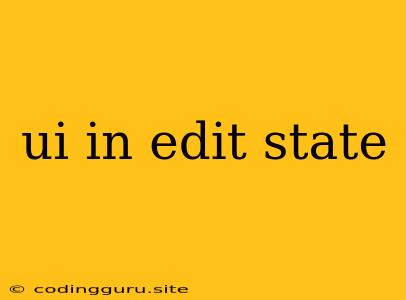Understanding UI in Edit State
In the realm of user interface (UI) design, the concept of "edit state" plays a crucial role in crafting intuitive and user-friendly experiences. Edit state refers to the specific visual and interactive behavior of a UI element when it's in a mode that allows users to modify its content. This transition from a passive display state to an active editing state is critical for a smooth and seamless user interaction.
Why is Edit State Important?
Imagine navigating a website or application where you can't readily edit information. This would create a frustrating experience, forcing users to resort to convoluted workarounds. The significance of UI in edit state lies in its ability to:
- Enable user modification: Edit state provides a clear pathway for users to make changes, be it text, images, or other data, within a defined interface.
- Provide visual feedback: The transition into edit state should be clearly communicated to the user through visual cues, such as changes in color, the appearance of input fields, or the highlighting of editable content.
- Enhance usability: By simplifying the process of editing, edit state promotes a more efficient and enjoyable user experience.
Common Elements in Edit State
The implementation of edit state varies depending on the specific UI element and the context of the application. However, some common elements are frequently employed:
- Input Fields: When an element is in edit state, input fields might appear for users to enter text, numbers, or other data.
- Editable Text: Text content can become editable, allowing users to directly modify the words or phrases within the interface.
- Buttons and Actions: Edit state may include buttons or actions that allow users to save changes, revert to the original state, or perform other editing-related tasks.
- Visual Cues: Edit state is often accompanied by visual cues, such as a change in background color, a border around the editable element, or the appearance of a cursor to indicate that the element is ready for user input.
Examples of Edit State Implementation
Let's consider some practical examples of edit state in action:
- Text Input: In a form field, clicking on the input field brings it into edit state, allowing the user to type in their information.
- Image Editing: When an image is in edit state, tools might appear for cropping, resizing, or adding filters.
- Content Management Systems: When editing content in a CMS platform, the interface typically transforms into edit state, offering tools for formatting text, adding media, and adjusting layouts.
Tips for Designing Effective Edit States
- Clear Visual Indicators: Use distinct visual cues to signal the transition into edit state. This might include color changes, borders, or the appearance of input fields.
- Simple and Intuitive Interactions: Strive for a straightforward and intuitive user experience. Users should understand how to enter and exit edit state without confusion.
- Consistent Design: Maintain consistency in the design of edit state across different UI elements. Users should recognize the patterns and be able to navigate the edit state effortlessly.
- Feedback and Confirmation: Provide feedback to the user after they make changes. This could involve displaying a confirmation message or visually updating the edited element.
Conclusion
UI in edit state is an essential aspect of modern user interface design. By thoughtfully implementing edit state functionality, developers can create interactive experiences that empower users to modify content and contribute to the application. Effective edit state design prioritizes clarity, intuitiveness, and user feedback, ultimately enhancing the overall usability and satisfaction of the application.
